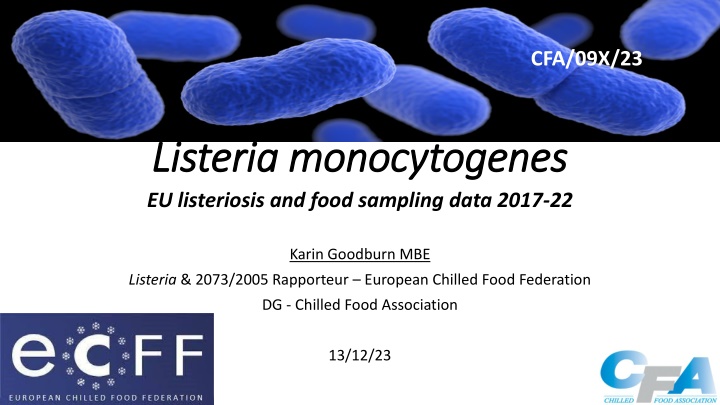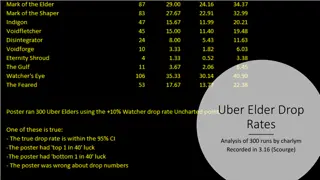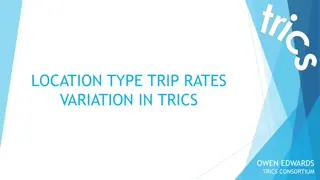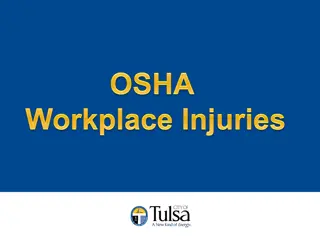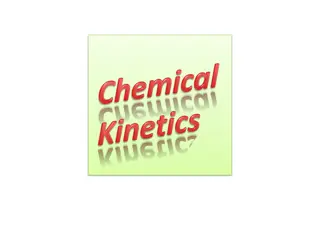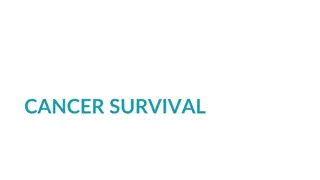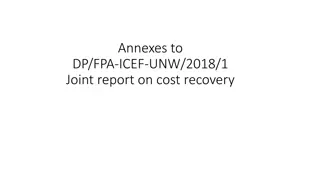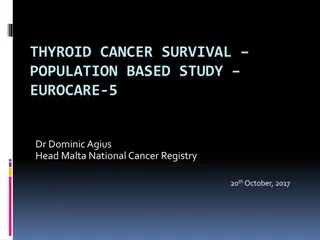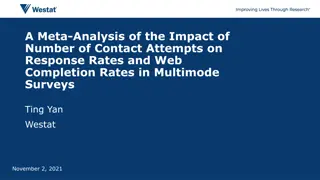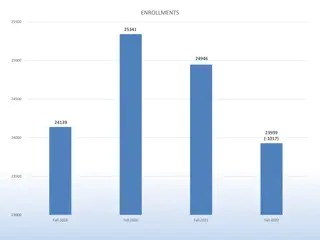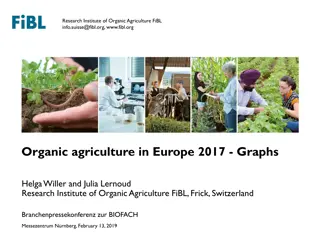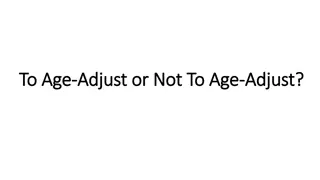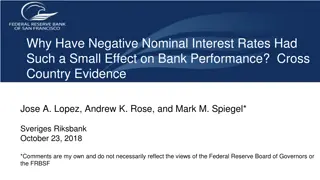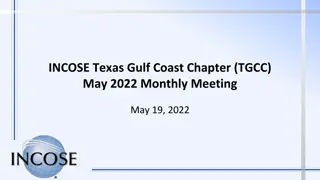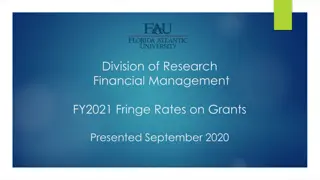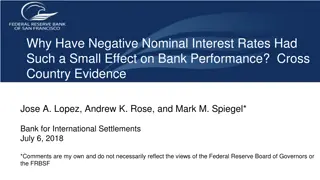Analysis of Listeriosis Rates in Europe 2017-2022
The data presents Listeriosis rates in various European countries from 2017 to 2022, showing cases and rates per country. The information reflects trends in foodborne diseases and highlights differences in morbidity and mortality rates across nations.
Download Presentation

Please find below an Image/Link to download the presentation.
The content on the website is provided AS IS for your information and personal use only. It may not be sold, licensed, or shared on other websites without obtaining consent from the author.If you encounter any issues during the download, it is possible that the publisher has removed the file from their server.
You are allowed to download the files provided on this website for personal or commercial use, subject to the condition that they are used lawfully. All files are the property of their respective owners.
The content on the website is provided AS IS for your information and personal use only. It may not be sold, licensed, or shared on other websites without obtaining consent from the author.
E N D
Presentation Transcript
CFA/09X/23 Listeria monocytogenes Listeria monocytogenes EU listeriosis and food sampling data 2017-22 Karin Goodburn MBE Listeria & 2073/2005 Rapporteur European Chilled Food Federation DG - Chilled Food Association 13/12/23
2022* EU27 Top 5 Foodborne Diseases Morbidity & Mortality Hospitalisations Deaths Outbreaks 2018 EFSA/ECDC Data Outcome available No. No No. Disease Status available (%) No. % Reported Deaths Case Related Cases Lm Fatality Rate cf confirmed cases reporting countries reporting MS No. Case rate hospitalised hospitalised Fatality (%) (%) Campylobacteriosis 453 137,107 44,876 16 10,551 23.5 61.6 17 34 0.04 255 1,097 45.1 Salmonellosis 82 65,208 29,003 17 11,287 38.9 56.5 17 81 0.22 1,014 6,632 15.3 Yersiniosis 7,919 2,113 17 636 30.1 47.5 17 0 0 14 96 2.2 STEC infections 31 7,117 2,933 17 1,130 38.5 67.8 21 28 0.58 71 408 2.1 Listeriosis 2,738 1,386 19 1,330 96.0 57.6 21 286 18.1 35 296 0.62 2020: Listeriosis death rate 260x Campylobacteriosis, 31x STEC 2019: Listeriosis death rate 586x Campylobacteriosis, 84x STEC 2018: Listeriosis death rate 520x Campylobacteriosis, 71x STEC 2017: Listeriosis death rate 345x Campylobacteriosis, 28x STEC 2016: Listeriosis death rate 540x Campylobacteriosis, 60x STEC EXCLUDES UK * EU One Health 2022 Zoonoses Report: https://www.ecdc.europa.eu/sites/default/files/documents/EFS2_8442.pdf **EU One Health 2021 Zoonoses Report: https://www.efsa.europa.eu/en/efsajournal/pub/7666 *** EU One Health 2020 Zoonoses Report, https://www.efsa.europa.eu/sites/default/files/2021-12/6971.pdf **** EU One Health Zoonoses Report 2019. https://www.efsa.europa.eu/en/efsajournal/pub/6406 ***** EU summary report on trends and sources of zoonoses, zoonotic agents and food-borne outbreaks in 2017. doi: 10.2903/j.efsa.2018.5500 ****** EU summary report on trends and sources of zoonoses, zoonotic agents and food-borne outbreaks in 2016. EFSA Journal 2017. 10.2903/j.efsa.2017.5077 Not all countries observed cases for all diseases
European Listeriosis Rates 2017-22 2018 Estonia Finland Spain Sweden Denmark Lux Germany Belgium Latvia Lithuania Portugal Switz Iceland France Slovenia EU + EFTA Norway Ireland NL Poland Austria Slovakia Czechia Italy Hungary UK Malta Greece Romania Bulgaria Cyprus Croatia Cases 27 80 370 89 49 5 683 74 15 20 64 52 2 338 10 2,549 24 21 69 128 27 17 31 178 24 168 1 19 28 9 1 4 Rate 2.05 1.45 0.89 0.88 0.85 0.83 0.82 0.81 0.78 0.71 0.62 0.61 0.57 0.51 0.48 0.47 0.45 0.43 0.4 0.34 0.31 0.31 0.29 0.29 0.25 0.25 0.21 0.18 0.14 0.13 0.12 0.1 2019 Spain Estonia Iceland Sweden Denmark Malta Slovenia Finland Belgium Germany NL France Portugal Norway Lux EU + EFTA Austria Switz Hungary Ireland Italy Slovakia Poland Latvia Czechia UK Lithuania Bulgaria Croatia Cyprus Greece Romania Cases 505 21 4 113 61 5 20 50 66 570 103 373 56 27 3 2,621 38 36 39 17 202 18 121 6 27 154 6 13 6 1 10 17 Rate 1.59 1.12 1.1 1.05 1.01 0.96 0.91 0.72 0.69 0.6 0.56 0.54 0.51 0.49 0.46 0.43 0.42 0.4 0.35 0.33 0.33 0.32 0.31 0.25 0.23 0.21 0.19 0.15 0.11 0.09 0.09 2020 Cases 191 94 26 4 5 88 44 37 58 544 4 54 90 334 41 47 8 Rate 1.7 1.2 1.1 0.97 0.85 0.76 0.69 0.67 0.65 0.64 0.59 0.52 0.5 0.46 0.46 0.42 2021 Cases 224 5 70 62 107 19 65 435 560 4 10 86 2,183 Rate 1.4 1.3 1.1 1 0.9 0.7 0.64 0.67 0.63 0.53 0.49 0.49 2022 Cases 86 70 125 437 20 87 78 11 548 451 64 2738 2848 Rate 1.5 1.3 1.2 0.95 0.95 0.94 0.89 0.83 0.66 0.66 0.66 0.62 Spain Finland Slovenia Iceland Malta Sweden Denmark Norway Switz Germany Lux Belgium NL France Austria Portugal Latvia Spain Iceland Finland Denmark Sweden Slovenia Belgium France Germany Lux Latvia NL Denmark Finland Sweden Spain Slovenia Belgium Switz Estonia Germany France Hungary EU 27 EU27+EFTA UK 2020 data: Food Security UK 2020 data: Food Security Report 2021. Report 2021. UK 2022 data UK 2022 data provisional provisional Sentinel system coverage: Sentinel system coverage: Belgium Belgium: 2016 : 2016- -21 80% pop (Surveillance not mandatory) (Surveillance not mandatory) Spain: Spain:2016 2016- -21 no info 21 no info Switz Switzincs Liechtenstein data to incs Liechtenstein data to 2020 2020 21 80% pop EU27 EU One Health EU One Health 2022 Report: Report: https://www.ecdc.europa.eu/sit es/default/files/documents/EFS 2_8442.pdf 2022 Zoonoses Zoonoses Lux Portugal Italy Norway NL Iceland Austria Czechia Slovakia Lithuania Latvia Poland Ireland UK* Malta Croatia Cyprus Bulgaria Greece Romania Liecht 4 0.62 0.61 0.58 0.55 0.53 0.53 0.52 0.46 0.46 0.46 0.43 0.38 0.34 0.28 0.19 0.13 0.11 0.07 0.07 0.07 2 2,268 38 241 5 33 20 35 120 14 184 7 13 24 21 8 1 11 3 0 0 0 0.44 0.43 0.41 0.38 0.38 0.37 0.36 0.32 0.28 0.27 0.25 0.24 0.22 0.2 0.2 0.11 0.06 0.04 0 0 0 EU27+EFTA Austria Italy Estonia Switz Norway Hungary Poland Ireland UK Lithuania Slovakia Czechia Greece Croatia Cyprus Romania Bulgaria Malta Liecht Portugal 63 345 30 94 2 47 48 25 13 8 142 17 151 1 5 1 5 7 14 0 EU27+ EFTA Hungary Italy Cyprus Estonia UK Greece Poland Czechia Slovakia Croatia Ireland Bulgaria Romania Lithuania 1,876 32 147 2 3 143 20 62 16 7 5 6 4 2 0 0.42 0.33 0.25 0.23 0.23 0.21 0.19 0.16 0.15 0.13 0.12 0.12 0.06 0.01 0 Non Non- -EU rates: EU rates: South Africa: South Africa: 1.84 (2017 USA: USA: Australia : Australia : NZ: NZ: US US rates: rates: cdc.gov/listeria/technical.html Australia: Australia: https://www.health.vic.gov.au/infe ctious-diseases/listeriosis#public- health-significance-and- occurrence-of-listeriosis NZ: NZ: www.foodstandards.gov.au/public ations/Documents/Listeria%20mo nocytogenes.pdf 1.84 (2017- -18) 0.24 0.24 0.3 (2013) 0.3 (2013) 0.6 0.6 18)
Distribution of European 2022 confirmed listeriosis cases by food, country EU One Health 2022 Zoonoses Report: https://www.ecdc.europa.eu/sit es/default/files/documents/EFS 2_8442.pdf UKHSA Oct 2022 report of 2020 data for England + Wales 2 outbreaks. 124 cases total, 17 deaths (non-pregnancy). 20% of all cases were pregnancy-related, 34.8% of which resulted in stillbirth or miscarriage
ECDC European Lm statistics related to invasive human infections 2018-22 2022 a 2021 a 2020 2019 b 2018 b Total no. confirmed Confirmed /100k No. reporting MSs EU-acquired Acquired outside EU Unknown travel status/ country of infection No. outbreak-related cases Total no. outbreaks 2,738 0.62 27 1,778 12 948 2,365 0.53 27 1,546 5 814 1,887 0.43 27 1,286 5 596 2,621 0.46 28 1,816 14 791 2,544 0.47 28 1,640 8 896 296 35 104 23 120 16 349 21 159 14 (a) Data on animal samples from the UK (NI) were taken into account for 2021. In accordance with the agreement on the withdrawal of the UK from the EU, and in particular with the Protocol on Ireland/NI, the EU requirements on data sampling are also applicable to NI. (b) Data from the UK were taken into account for the 2018 2019 period, since the UK was still an EU MS at that time. However, on 1 February 2020 it became a third country. EU One Health 2022 Zoonoses Report: https://www.ecdc.europa.eu/sites/default/files/documents/EFS2_8442.pdf
Seasonality, Europe: Jan 2013-Oct 2022 EU One Health 2022 Zoonoses Report: https://www.ecdc.europa.eu/en/publications-data/european-union-one-health-2022-zoonoses-report Covers: Austria, Belgium, Cyprus, the Czech Republic, Denmark, Estonia, Finland, France, Germany, Greece, Hungary, Iceland, Ireland, Italy, Latvia, Lithuania, Malta, the Netherlands, Norway, Poland, Romania, Slovakia, Slovenia, Spain, Sweden and UK. Bulgaria, Croatia, Luxembourg and Portugal did not report data to the level of detail required for the analysis. Source: .Excludes UK
Major RTE food categories sampled in EU, 2018 2022 (EFSA) No. sampling units tested (detect. or enum.) 2022 2021 2020 2019 2018 Meat & meat products No. sampling units 135,148 107,198 40,291 64,971 58,060 No. reporting MSs 24 23 22 22 22 Fish & fishery products No. sampling units 25,009 29,783 11,212 13,366 14,031 No. reporting MSs 24 24 23 22 22 Milk & milk products No. sampling units 97,157 66,633 49,132 61,866 59,313 No. reporting MSs 24 23 23 23 23 Products intended for infants or special medical purposes No. sampling units 2,672 2,764 2,394 2,346 2,433 No. reporting MSs 19 19 19 19 18 Other products 2018-2019 inc UK No. sampling units 120,530 94,841 81,575 80,167 28,204 No. reporting MSs 25 23 24 24 23 EU One Health 2022 Zoonoses Report: https://www.ecdc.europa.eu/sites/default/files/documents/EFS2_8442.pdf
Commentary on Major RTE food categories sampled in EU 2022 26 MSs reported a total of 312,489 samples from different RTE food categories from distribution or manufacturing stages - an increase of 26.3% over 2021. Focus was on POAO. At distribution, proportion Lm +ves was <0.1% to 1.0% except for fish (2.3%). At manufacture the proportion of +ves was higher for all categories except milk where there were no detections at either stage. Highest +ve categories were fish (2.6%), fishery products (2.5%) & products of meat origin other than fermented sausages (2.5%) Lm occurrence results varied according to the RTE food category and the sampling stage. Including all samplers and sampling units occurrences remained generally rare (<1%) to low (1% to 10%) in these categories, except fish/fishery products , meat products from bovines or pigs , fruits & vegetables & cheeses from sheep milk . 11 MS took 22,370 samples from primary production (not crops). +ves in pigs were (0.35%) & in cattle (1.2%) EU One Health 2022 Zoonoses Report: https://www.ecdc.europa.eu/sites/default/files/documents/EFS2_8442.pdf
Major RTE food categories sampled by EU Competent Authorities at manufacturer, 2022 NB: https://www.efsa.europa.eu/en/microstrategy/listeria-dashboard https://www.arcgis.com/apps/dashboards/a5e5fd9ce37a4802b4f34ff2bcd9ed1a
Major RTE food categories sampled by Competent Authorities at point of sale in EU, 2022 NB: https://www.efsa.europa.eu/en/microstrategy/listeria-dashboard https://www.arcgis.com/apps/dashboards/a5e5fd9ce37a4802b4f34ff2bcd9ed1a
From CFA Members Lm Database: Jan 2011-Dec 2022 Production environment prevalence (1,947,956 samples): RTE food prevalence (1,050,585 samples): 0.6% Lm at any point during shelf life, of which 0.01% present at quantifiable levels, i.e. >20 cfu/g LOQ Food contact surfaces: ~0.3% Lm (~964k samples) Non-Food contact: ~2.5% Lm (~984k samples) DOP: 97 quantifiable out of 822,204 samples Data also split into During Production, Post Hygiene EOL: 50 quantifiable out of 228,381 samples Data also split into raw, raw+cooked, cooked
Evidence & Conclusions Epidemiology shows that 100/g limit drives sampling/monitoring, compliance with best practice and when enforced commercially achieves high levels of consumer protection UK (and IE) listeriosis rates are consistently well below European (EU + EFTA) mean. Note ECDC/EFSA figures inc UK as EU MS to end 2019: Rate per 100k 2010 2011 2012 2013 2014 2015 2016 2017 2018 2019 2020 2021 2022 Europe inc UK 0.37 0.33 0.41 0.44 0.52 0.46 0.48 0.48 0.47 0.46 UK 0.28 0.26 0.29 0.30 0.31 0.29 0.31 0.24 0.25 0.23 0.22 0.27 0.28* Europe exc UK 0.39 0.34 0.43 0.46 0.56 0.49 0.50 0.52 0.50 0.49 0.42 0.49 0.62 Day of Production (DOP) and End of Life (EOL) sampling, trending and analysis works as a means of demonstrating control and shelf life appropriateness Aggressive continuous environmental sampling to find Listeria spp, attacking with hygiene and is an effective strategy for factory hygiene control * provisional
Example of US experience with Zero Tolerance/Not Detected Lack of evidence of control/ safety data for B2B Mass recalls and potential widespread outbreaks ZT/ND policy (law or commercial) Undetected eventual loss of control Widespread long term product contamination by ingredients Lack of food safety assurance data Eventual illness / discovery of Lm in foods Reduced Lm testing (food contact, product) 17
Examples of Fatal Listeriosis Outbreaks & Root Causes Country (year) UK (1987-9) France (1992) USA (1998-9) Canada (2008) USA (2010-15) USA (2011) Denmark (2014) USA (2014) Europe (2015-18) South Africa (2017-18) Netherlands, Belgium (2017-19) 3 dead, 21 cases. Cooked meat product. Post-process contamination Australia (2018) 6 dead, 19 cases. Cantaloupes. Field contamination, processing contamination Germany (2019) 7 dead, 1 miscarriage, 112 cases. Cooked meat product. Post-process contamination Spain (2019) 3 dead, 38 miscarriages, 222 cases. Cooked meat product. Post-process contamination Outcomes and Root Causes >17 dead, 200+ cases. P t imported from Belgium. Post-process contamination 92 dead, 272 cases. Jellied pork tongue. Post-process contamination 17 dead, 4 miscarriages/stillbirths, 101 cases. Cooked meat. Air filtration maintenance contamination 22 dead, 57 cases. CAD 27m. Cooked sliced meat. Dirty slicer. Post-process contamination 3 dead, 10 cases. Ice cream used by hospital to make milkshake. Equipment contamination 33 dead, 147 cases. Cantaloupes. Contaminated production. Washing process validated? 17 dead, 41 cases. Cooked meat (rullep lse). Post-process contamination 7 dead, 35 cases. Caramel apples. Contaminated production. Washing process validated? 6 dead, 32 cases. Frozen sweetcorn eaten raw (non-RTE) but not High Care grown or handled 216 dead, 455 miscarriages, 1060 cases. Cooked RTE meat products. Post-process contamination listeriosis outbreaks where a root cause has been identified (79/88) have been caused by cross contamination post-process FAO/WHO (2022) Lm in RTE food: attribution, characterization & monitoring. https://www.who.int/publications/i/item/9789240034969 18
Industry (ECFF + CLITRAVI + ESmSA + ESpSA) Position These data demonstrate that DOP and EOL sampling, trending and analysis and environmental hygiene monitoring and control as specified in 2073/2005 works as a means of demonstrating control and shelf life appropriateness, hygiene management and give a high level of consumer health protection. It is not possible to make clean food in an unclean production environment, nor to assemble a final RTE food from chilled RTE ingredients that are microbiologically not of the appropriate standard. The production environment, the ingredients and final product shelf life must be demonstrated continuously to be well-controlled, which is what DOP, EOL and environmental monitoring do. CODEX allows for data from naturally contaminated foods to be used in shelf life setting, setting precedent
Industry (ECFF + CLITRAVI + ESmSA + ESpSA) Position Challenge testing of foods: Does not reflect actual control of the supply chain or of a production plant s environmental hygiene Artificially shortens shelf lives leading to waste. Particularly likely to be affected are Continental products and potentially UK foods Uses high numbers of log phase rapid growth strains not reflecting real life contamination or the stressed nature of organisms in food plants (effect of cold, biocides etc) Results only apply to that particular formulation Has insufficient laboratory capacity to test the myriad of foods in question Is highly costly and therefore not viable for SMEs in particular Diverts companies and authorities money away from implementing meaningful everyday hygiene controls Challenge Testing should remain voluntary and not required by law
The voice of the European chilled food industry www.ecff.eu
